

Yacht vs. Portainer: Docker Interface Comparison
- Post author: WunderTech
- Post last modified: May 10, 2024
- Post category: Docker
- Reading time: 11 mins read
In this article, we’re going to look at Yacht vs. Portainer to determine which Docker management interface is best.
If you’re using Docker in any capacity, you know that interacting with it through the command-line interface (CLI) can be frustrating. Yacht and Portainer offer a full GUI for Docker, which allows you to manage all of your Docker containers in an easy-to-use management user interface.
Yacht and Portainer are similar, but have key differences from an everyday usage perspective, so we’ll compare some of their features and capabilities below to help you determine which option is best. These are great options but keep in mind that you can go with totally different options as well like Rancher .
Do You Need a Management Interface for Docker?
Technically, you can use Docker through the command-line interface only, and using a management interface like Yacht or Portainer isn’t necessary. However, they simplify the overall operation of both and allow you to easily manage your Docker containers with a great GUI.
This allows you to manage existing containers, or simply create new ones in an easier way and beginners may find the user interface necessary for everyday usage. It also helps to visualize how containers function which can give you a better overall understanding of how Docker works .
What is Yacht?
What is portainer, yacht & portainer install instructions, main difference between yacht and portainer, conclusion & final thoughts, yacht vs. portainer: side-by-side comparison.
We’ll take a look at the major differences between Yacht and Portainer below, but before we do, let’s look at what Yacht and Portainer are.
Yacht is an application that provides a web interface for managing Docker containers with an emphasis on simplicity and ease of use. It is an open-source project that can help users, especially those new to Docker, manage their containerized applications more easily.
Yacht allows users to create, start, stop, and monitor Docker containers from a web-based user interface. You can manage multiple containers simultaneously, view real-time logs, inspect container details, and access other Docker features without having to write a single line of code or command-line instructions.

Features of Yacht
Yacht has many features that are similar to Portainer, but the key difference is that the entire user interface is designed with simplicity in mind. Here are some key features of Yacht:
- Application Deployment: You can deploy applications using Docker Compose or pre-made templates.
- Container Management: Start, stop, and monitor Docker containers directly from the web interface.
- Logs and Statistics: Real-time access to logs and stats of your containers.
- Easy Yacht Update: Yacht has one of the easiest ways that I’ve seen for updating a Docker management user interface (and is much easier than Portainer ). All you have to do is access the settings and the update tab, and you can update Yacht to the latest version by using a run-once Watchtower instance.

Portainer is an open-source platform that provides a user-friendly interface for managing Docker, Docker Swarm, Kubernetes, and Azure ACI environments. It allows users to manage their containerized applications, images, networks, and volumes from a single, unified dashboard.
With Portainer, you can deploy applications, monitor the status of running containers, and troubleshoot application issues without using the command-line interface. This is particularly useful for teams that are new to Docker or Kubernetes, as well as for experienced developers looking for a more efficient way to manage their applications.
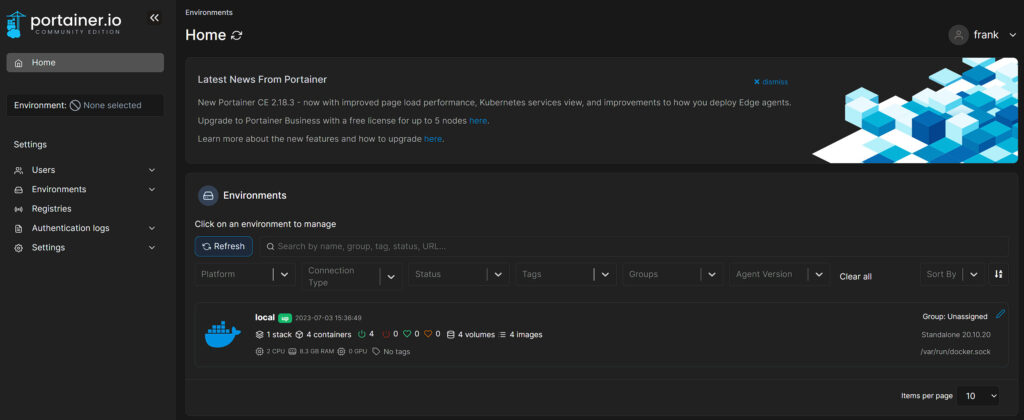
There are various devices that users like to install Portainer on , as it’s one of, if not the most commonly used Docker management interface.
Features of Portainer
Portainer has all of the functionality that Yacht has, plus many additional items:
- Container Management: Create, start, stop, and monitor Docker containers directly from the web interface. You can also access logs, stats, and console details of each container.
- App Templates: Deploy pre-built templates for common applications with just a few clicks, saving time in setting up and deploying new containers.
- Role-Based Access Control (RBAC): Assign roles to users and manage their access to resources.
- Multi-Environment Management: You can manage multiple Docker environments (Docker standalone, Docker Swarm, or Kubernetes) from a single Portainer instance.
- Registry Management: Connect to and manage Docker registries, making it easier to store and distribute your Docker images.

Yacht and Portainer are installed as containers , so their individual setup process is similar to any other Docker container. However, since they’re a GUI, you generally must install them both from the command-line interface.
Fortunately, the install process is an individual command and you don’t have to worry about modifying many (if any) parameters. The volume for each will allow you to maintain persistent data (in case you ever want to move them).
Yacht Install Command:
Portainer Install Command:
There are also scenarios where you can install Yacht and Portainer automatically, like if you’re using OMV-extras and OpenMediaVault .
The main difference between Yacht and Portainer is that Yacht is significantly more user-friendly, while Portainer is more feature-filled.
Overall, Portainer and Yacht are designed to simplify Docker management through their user-friendly web-based interfaces and Yacht generally excels from a simplicity perspective. Portainer, on the other hand, is significantly more feature-filled and provides users with the ability to manage other environments like Docker Swarm and Kubernetes.
Here are a few other key differences between Yacht and Portainer:
- Project Maturity: Portainer is a more mature project, having been around since 2015. It has seen widespread adoption and developed a sizable user community. On the other hand, Yacht is a newer project and has a smaller user base.
- Supported Environments: Portainer has wider environment support, extending its functionality beyond Docker and Docker Swarm to include Kubernetes and Azure ACI. Yacht primarily focuses on Docker environments.
- User Interface: The user interfaces of Portainer and Yacht differ significantly. Yacht maintains a minimalistic and straightforward interface, focusing on simplicity and ease of use. Alternatively, Portainer has a more comprehensive interface, providing a greater array of options and functionalities for those requiring more control and customization.
- Role-Based Access Control (RBAC): Portainer supports RBAC, which is an important feature for teams as it allows administrators to define access levels and permissions for different users.
- Application Templates: Both platforms support application deployment using templates, but they handle it differently.
This tutorial looked at the differences between Yacht vs. Portainer. If you’re someone who prefers simplicity, you can’t go wrong with Yacht as it will allow you to manage your Docker containers and doesn’t provide any of the advanced features (which some will classify as bloat) that Portainer does.
However, from a pure functionality perspective, Portainer is significantly more feature-filled and will provide users and teams to manage significantly more when it comes to their containers.
To highlight that, Portainer has a free (Community Edition) and business tier (Business Edition), which offers a different set of features depending on the requirements. Individuals and home lab enthusiasts will be fine with the Community Edition, though the Business Edition exists for enterprise use.
Either way, you can’t go wrong, and in many cases, should try both (they’re both free) to determine which you like best. Thanks for checking out the article on Yacht vs. Portainer. If you have any questions, please leave them in the comments!
Share what you're reading!
You Might Also Like

How to Install Pi-hole on Portainer

Monitor your Entire Home Lab with Uptime Kuma
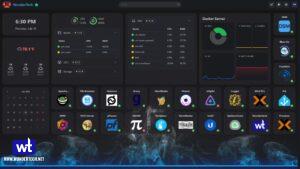
Configuring a Home Lab Self-Hosted Dashboard with Homarr

How to Install HandBrake in Docker

Yacht vs. Portainer – Docker dashboard comparison
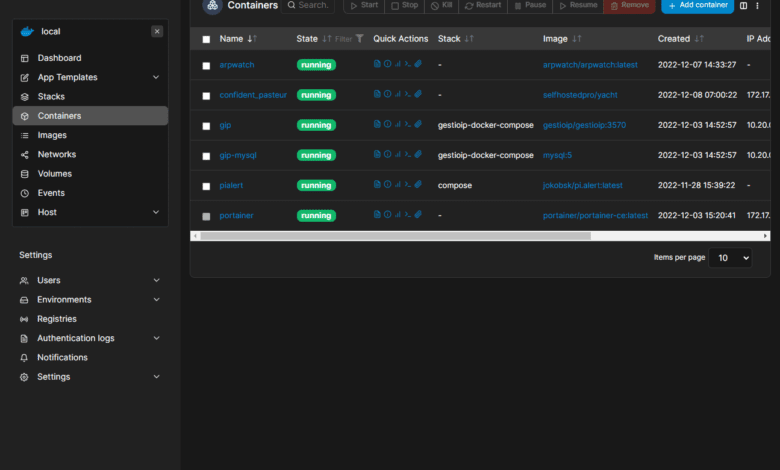
When you start working with Docker or containers in general, one of the first things you will probably want is some type of GUI to help with day-to-day workflows and operations for managing Docker containers and Docker apps with an easy-to-access web interface. There are a couple of solutions out there providing great Docker containers dashboard solutions, Yacht and Portainer. Let’s look at Yacht vs. Portainer and see what features and capabilities each offers.
Take a look at my video comparison of the two products here:
Why a Docker containers dashboard solution?
As you get into working with Docker containers, having a GUI tool to interact with your containers saves time and helps to visualize the Docker app’s infrastructure. Docker has a very robust command line interface, allowing you to do basically anything you need to do from the command line.
However, for newbies starting out and day-to-day management, the command line can be cumbersome for carrying out the required activities. A point-and-click interface to navigate your Docker infrastructure offers many advantages for managing Docker applications.
What is Yacht?
To begin, what is Yacht? Yacht is a web interface for managing Docker containers and focuses on templating. With templates, you can have one-click deployments of dockerized applications.
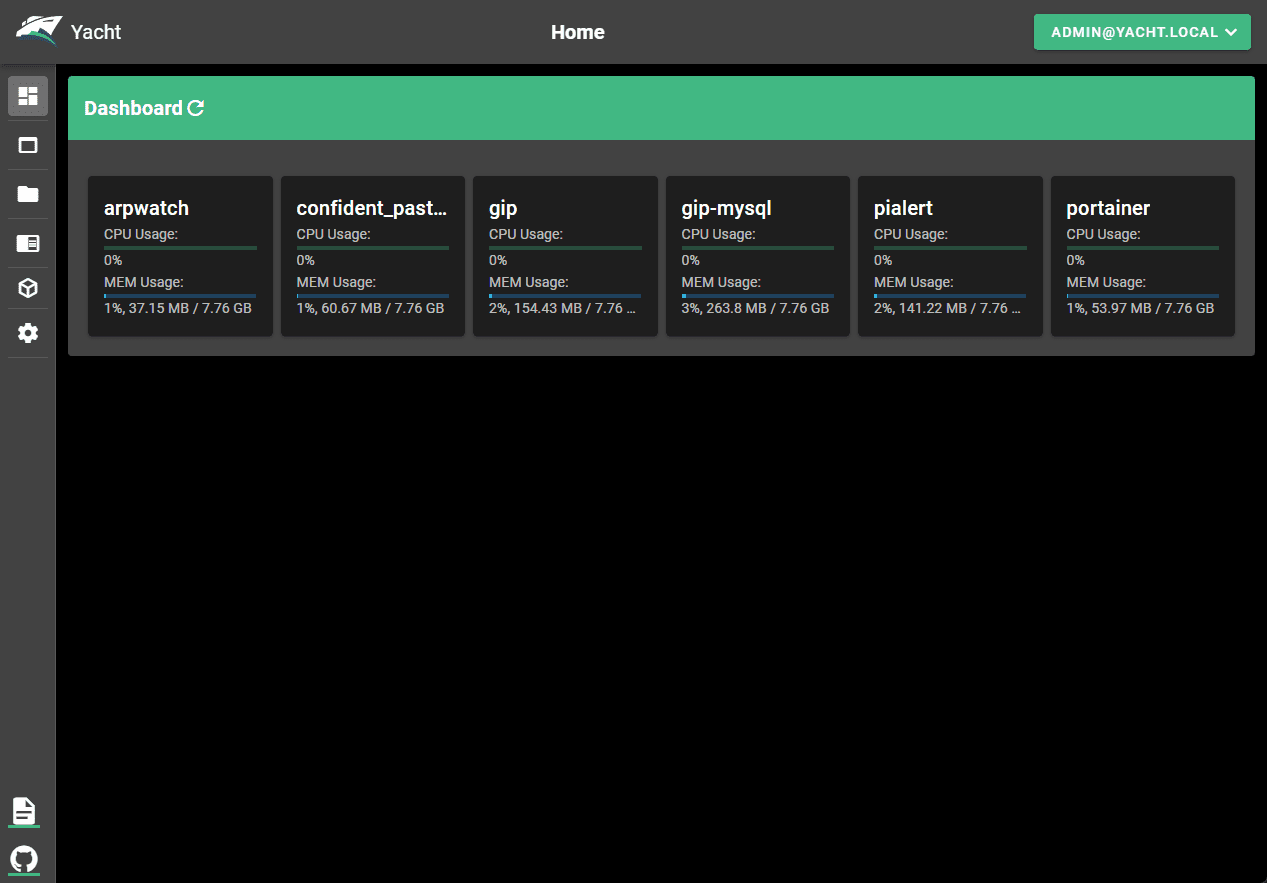
Yacht refers to this as a decentralized app store for servers for which you can make packages in your environment. It is considered to be a Portainer alternative and provides many of the same features in a yacht compare Portainer comparison.
Features of Yacht
Comparing Yacht vs. Portainer, Yacht provides many features for those wanting to manage their Docker apps and containers. Those include the following:
Templating functionality (Portainer compatible)
Container management (basic features)
Updating templates
Use template variables for one-click deployment
Container deployment wizard
Docker containers dashboard for seeing all containers in one place
Docker compose support and editor
One-click editing of containers and lifecycle management
Ability to view logs
Create Projects (Docker compose)
Nice menu driven interface from the left side
So, Yacht allows you to run multi-container applications with a GUI dashboard interface to interact with your containers from a simple website interface.
Compose Support
Yacht does include Docker compose support, using the built-in Projects included with Yacht. Using the Projects feature, you can enter a new Compose Template.
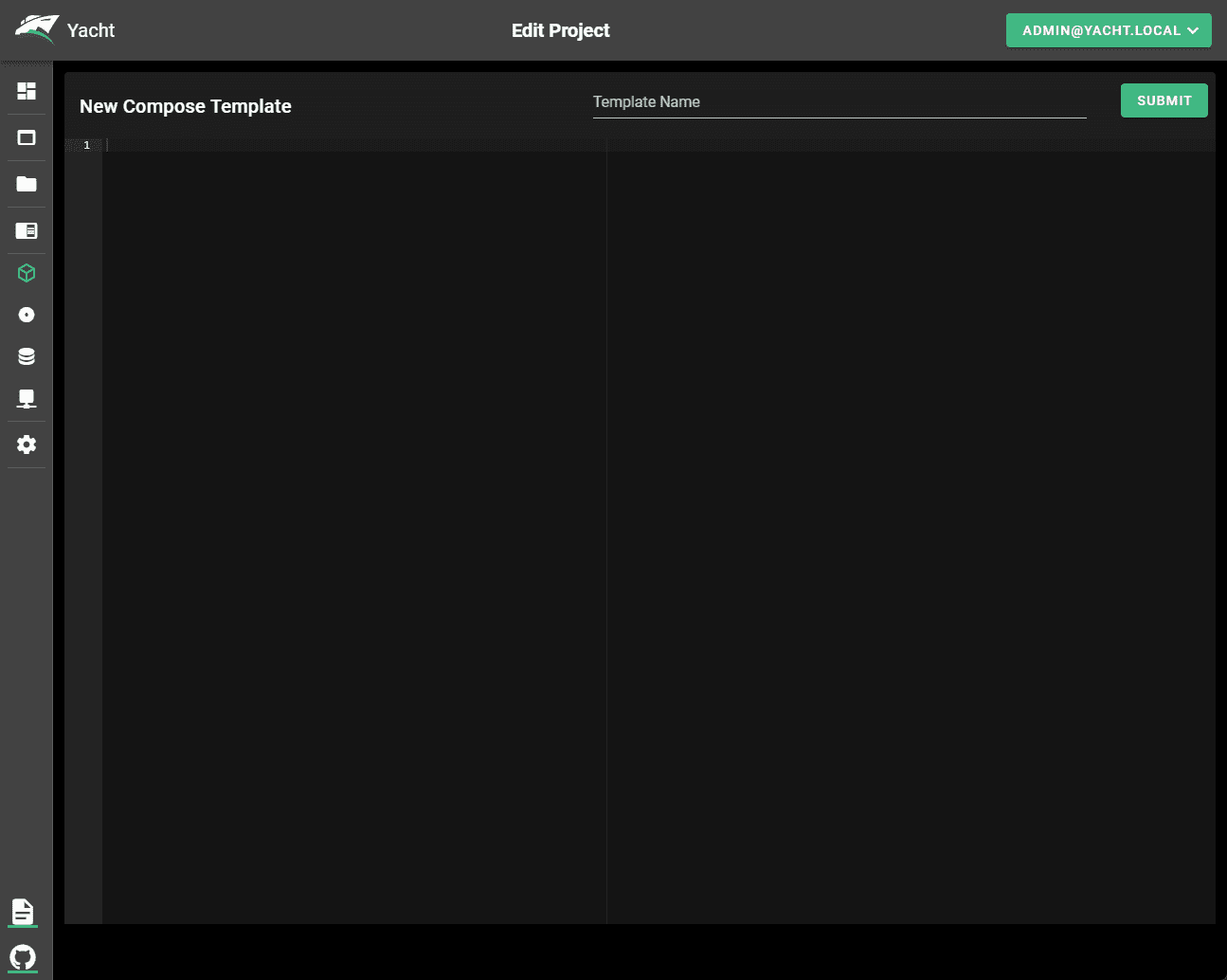
Missing features currently
A call out to a feature that I would like to see on a Yacht machine is the ability to access your containers CLI from the Yacht GUI. This is a feature that Yacht mentions are coming soon.
The features marked as “coming soon” currently include the following:
User Management
Container CLI attachment
Another feature in Yacht that isn’t quite as good as Portainer is the App
Podman support
One cool feature that I like with Yacht is it is compatible with Podman. You can perform the same installation with Podman as you can with Docker:
Yacht install
If you are not installing in a self-hosted Docker server , there are a few options for installing Yacht. These include Docker, OpenMediaVault, Docker Compose, or DockSTARTer. The process to install Yacht in a self-hosted environment is super simple.
Self-hosted Yacht install example
For a self-hosted Docker instance, you have two lines to enter to get up and running:
Many who want to try out Yacht may already be running Portainer. If that is the case, you will need to adjust the external port 8000 to 8001 or something else to run them side-by-side.
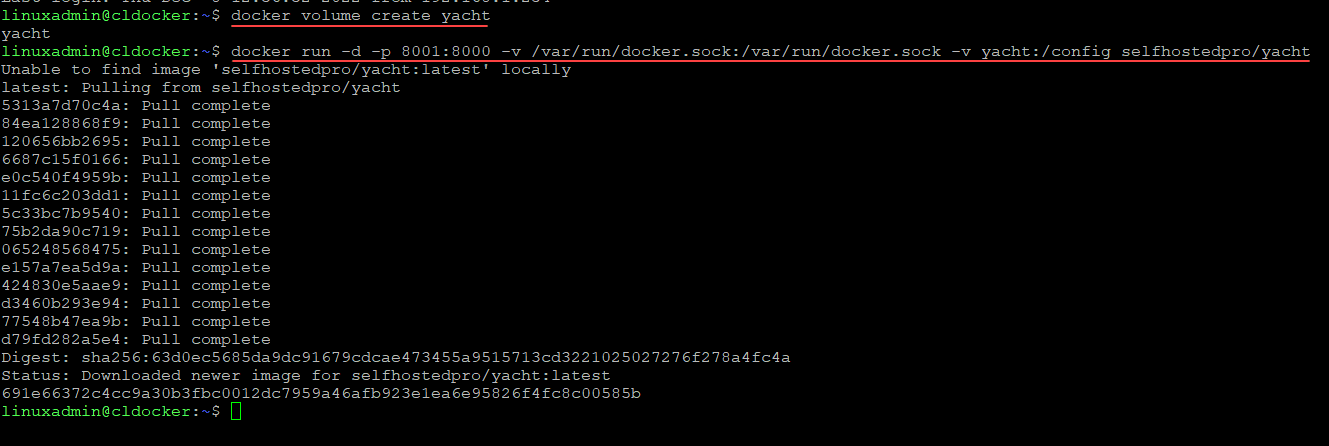
Log in with the [email protected] pass credentials.
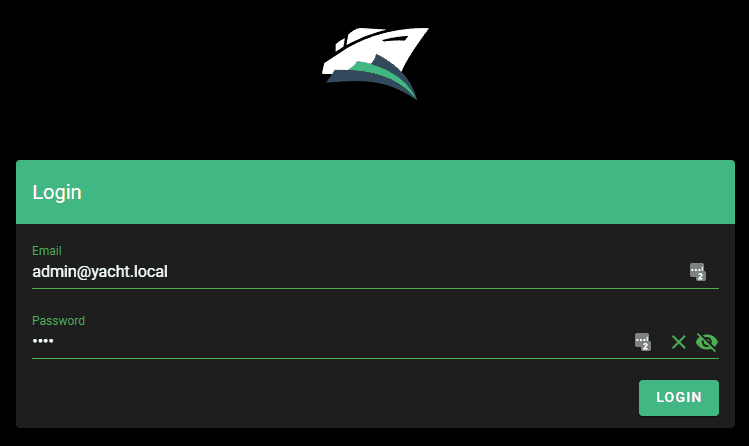
What is Portainer?
Portainer is a well-known container management platform providing a rich GUI interface to work with your containers, applications, templates, config maps, secrets, etc. It helps to reduce the complexity of container adoption and addresses security challenges.
Portainer works with more than Docker
Comparing Yacht vs. Portainer, Portainer is not only a tool that understands Docker apps, it also understands and works with Docker, Swarm, Nomad, and Kubernetes. Comparing Portainer to Yacht, it is a much more fully-featured tool that is also much more polished in its look and feel. It has been around longer and shows from a feature and useability standpoint.
Below is the overview dashboard of the Portainer connected to a Docker host.
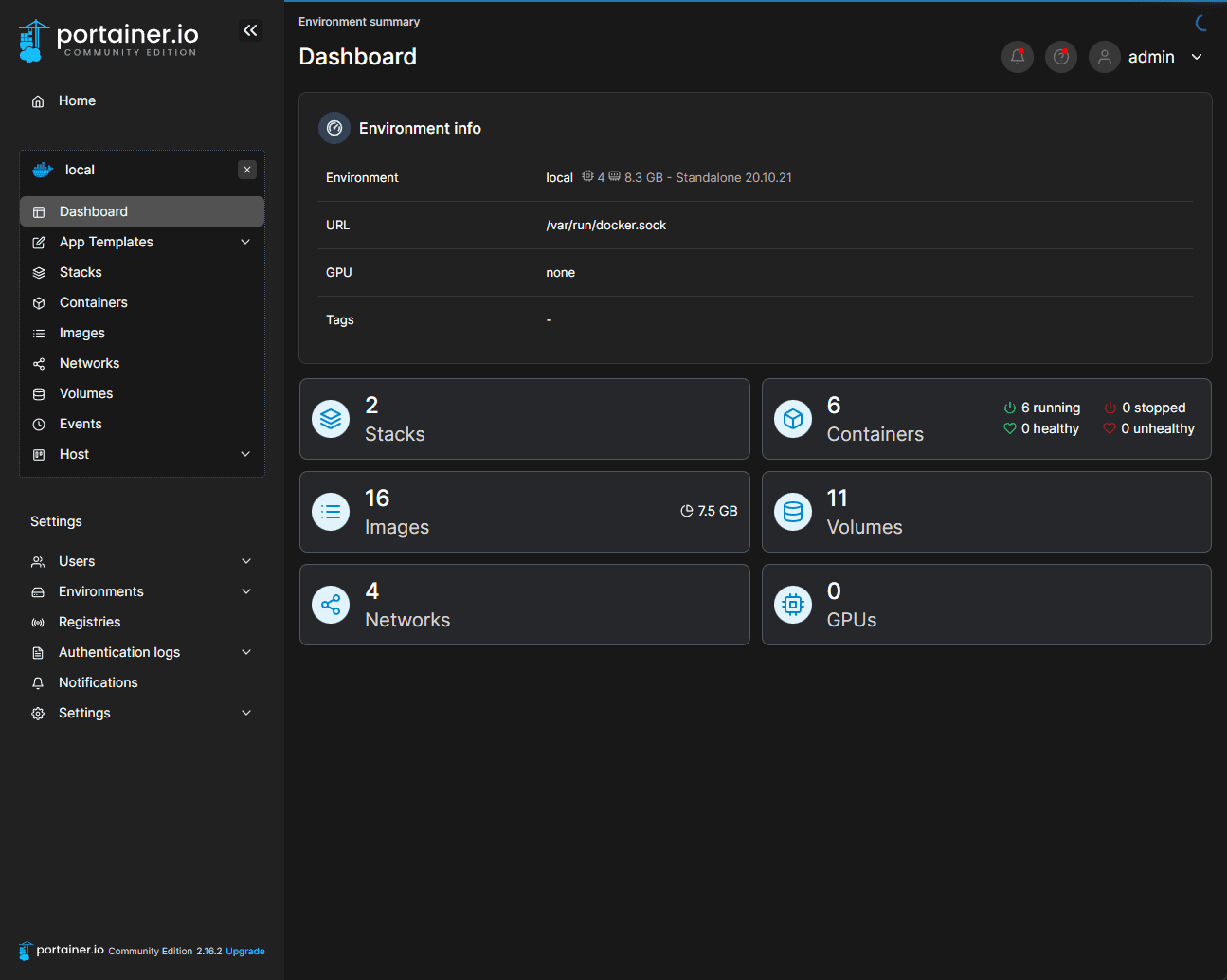
Looking at your list of running containers.
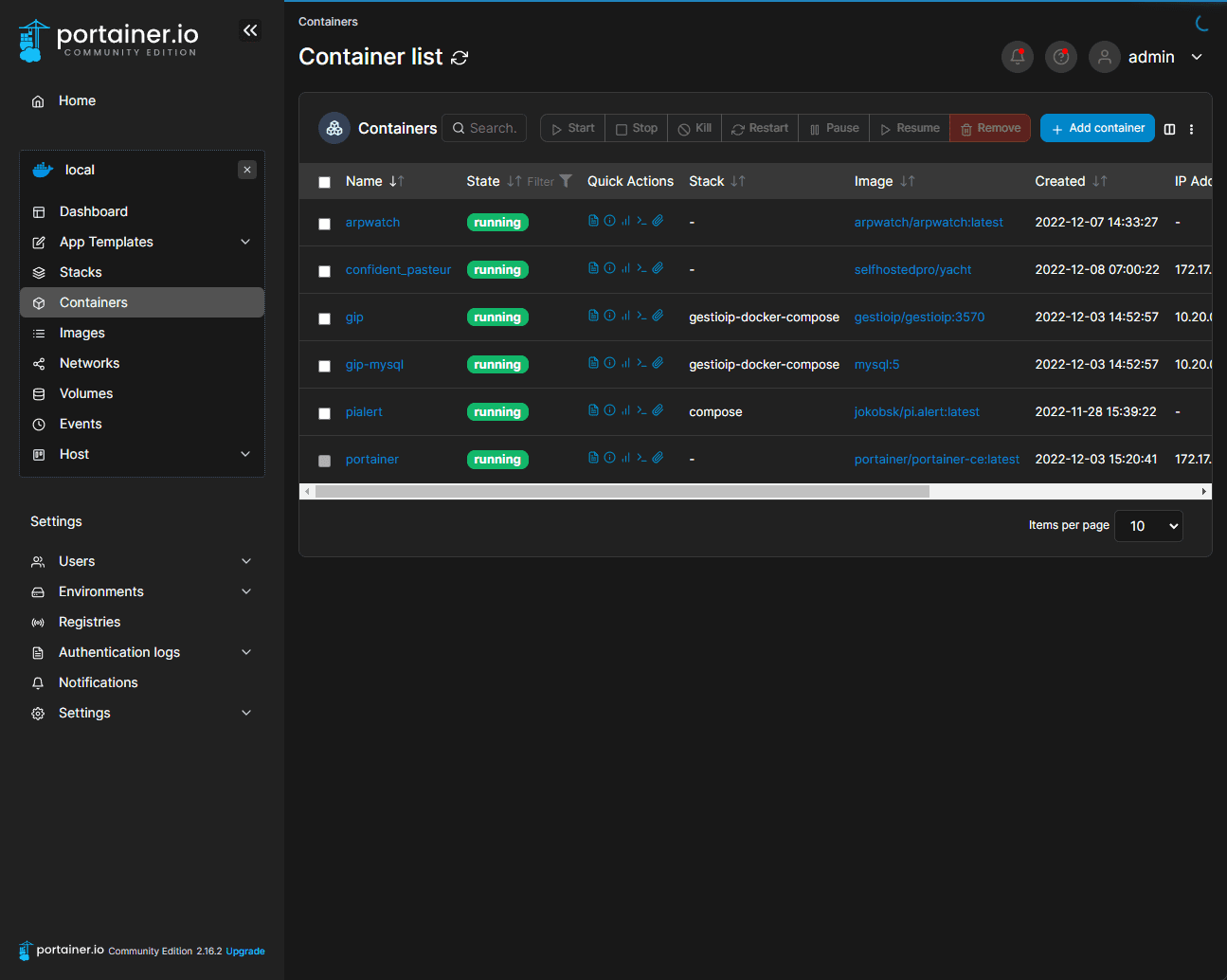
Portainer features
Portainer has many great features, including:
Overview dashboard
Image management
Built-in app templates
Visibility of Docker networking
Volumes, events, and host configuration
Ability to implement stacks using Docker Compose
Docker exec console – Managing Docker containers
Using the Docker exec console provides a great way to access the Docker CLI when needed from the Docker dashboard. As this is currently a feature missing from Yacht, Portainer is the tool of choice if this is a requirement. Honestly, it is a great feature to be able to expect to the console when needed directly from your Docker container dashboard.
Portainer install
The Portainer installation is very similar to Yacht. It is a couple of commands to get started with a self-hosted environment:
Portainer Community Edition vs. Business Edition
There are two versions of Portainer available – Community Edition and Business Edition. To note the difference between those two versions, Community Edition is free and open-source software. It is designed for individuals, home lab users, or very small environments that want to use Portainer.
Business Edition is commercially supported software. It includes features with Security, Access Management, Permissions, Auditing, and making ensuring you want to take Portainer into production.
Final Thoughts comparing Yacht vs. Portainer
Looking at Yacht vs. Portainer, both Yacht and Portainer are excellent free and open-source tools allowing you to manage and configure your Docker containers in a web interface using a modern GUI. Yacht is definitely the newer and less fully-featured tools of the two. I really like what I see with Yacht. However, it is missing some of the bells and whistles provided by Portainer, like exec CLI support from the interface.
Portainer also provides Kubernetes integration which does not appear to be supported by Yacht. Yacht has documented support for Podman, which isn’t shown with Portainer, although several blog posts cover how to install Portainer with Podman.
Check out Yacht here: Welcome To Yacht | Yacht
Check out Portainer here: Powerful container management software for Platform Teams, DevOps, Dev ( portainer.io )
Subscribe to VirtualizationHowto via Email 🔔
Enter your email address to subscribe to this blog and receive notifications of new posts by email.
Email Address
Brandon Lee
Related articles.
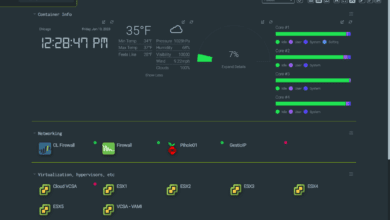
Best docker containers for Synology NAS
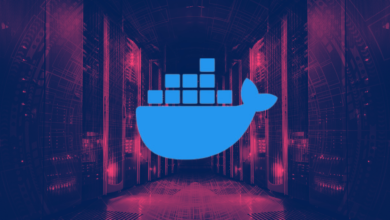
Best Docker Containers Commands You Need to Know
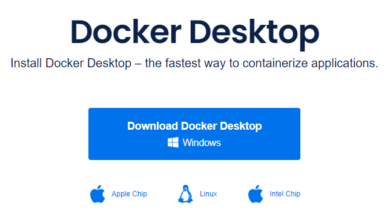
Docker Desktop Starting Forever Windows 11 or 10 Error
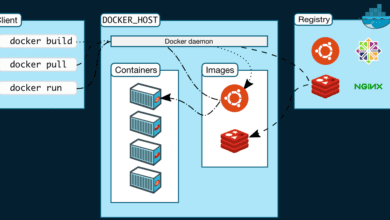
Best Docker Containers for Home Server
Leave a reply cancel reply.
This site uses Akismet to reduce spam. Learn how your comment data is processed .
A web interface for managing docker containers with an emphasis on templating to provide one-click deployments of dockerized applications. Think of it like a decentralized app store for servers that anyone can make packages for.
Additional support and community assistance can be found in our Discord group, https://discord.gg/JfsebxqKDW
Features- Container templating compatibility (Portainer compatible)
- Basic container management
- Easy template updating
- Template Variables to allow for a one-click experience
- Guided container deployment
- Dashboard for monitoring all of your docker containers in one place
- Docker-compose compatibility and editor
- One click editing of containers
Features (Coming Soon!)
- User Management
- Container CLI attachment If you want something that's not planned please open a feature request issue and we'll see about getting it added.
Templates
Currently, Yacht is compatible with portainer templates. You'll add a template url in the "Add Template" settings. The template will be read, separated into apps, and imported into the database. The apps associated with the templates are linked via a db relationship so when the template is removed, so are the apps associated with it. We store the template url as well so we can enable updating templates with a button press.
We recommend starting with:
In templates you are able to define variables (starting with ! ) to have them automatically replaced by whatever variable the user has set in their server settings (ie. !config will be replaced by /yacht/AppData/Config by default).
Control Local Docker Containers From a Web Browser with Yacht
What is yacht.
Yacht is a web interface for managing docker containers with an emphasis on templating to provide one-click deployments of dockerized applications. Think of it like a decentralized app store for servers that anyone can make packages for. - https://yacht.sh/docs/
Installing Docker
- Log into the Linux based device
- Run the following commands in the terminal # install prerequisites sudo apt install apt-transport-https ca-certificates curl software-properties-common gnupg-agent -y # add docker gpg key curl -fsSL https://download.docker.com/linux/ubuntu/gpg | sudo apt-key add - # add docker software repository sudo add-apt-repository "deb [arch=amd64] https://download.docker.com/linux/ubuntu $(lsb_release -cs) stable" # install docker sudo apt install docker-ce docker-compose containerd.io -y # enable and start docker service sudo systemctl enable docker && sudo systemctl start docker # add the current user to the docker group sudo usermod -aG docker $USER # reauthenticate for the new group membership to take effect su - $USER
Running Yacht
- Now that Docker is installed, run the following commands to setup the Yacht Docker container and run it # create working directories mkdir ~/docker/yacht -p # run the yacht docker container docker run -d -p 8000:8000 -v /var/run/docker.sock:/var/run/docker.sock -v ~/docker/yacht:/config --restart unless-stopped selfhostedpro/yacht
- Once the Yacht container is downloaded and running, open a web browser and navigate to http://DNSorIP:8000
- Login with the username [email protected] and password pass
- Click Admin > User in the top right corner
- Select Change Password from the top navigation menu
- Enter and confirm a new password
- Optionally, change the username
- Click the Change User Info button to apply the changes
- Welcome to Yacht, Docker container management from a web browser
Documentation: https://github.com/SelfhostedPro/Yacht

The Future of AI: A Conversation with Eric Schwarz


How To Learn Programming 10x Faster With AI

Is the AI Left-Bias Real?

How to Use OpenShift Dynamic Plugins to support GitOps

10 Important Python Concepts In 20 Minutes
Yacht – an open source, self hosted, modern, web gui for docker management.
- May 9, 2022
- Containers Open Source

Here’s an interesting new opensource project.
TIME STAMPS
- 00:00 Beginning
- 00:09 Introduction to Yacht
- 02:50 Thank you to all my Patrons over at Patreon
- 04:25 Install Yacht using Docker-Compose
- 08:00 Logging into Yacht UI for the first time
- 10:00 Change our Yacht Default Credentials
- 10:35 Yacht Dashboard and Container Details
- 13:05 Applications View
- 13:55 Check for New Versions of Containers
- 14:35 Container Detail – Top Tabs
- 15:20 Projects in Yacht – Adding Custom Docker Apps
- 17:05 Resources in Yacht
- 17:50 Settings in Yacht
- 19:15 Templates in Yacht for Pre-built Apps
#DataScientist, #DataEngineer, Blogger, Vlogger, Podcaster at http://DataDriven.tv . Back @Microsoft to help customers leverage #AI Opinions mine. #武當派 fan. I blog to help you become a better data scientist/ML engineer Opinions are mine. All mine.
- Yachting Monthly
- Digital edition

How to improve power management on a yacht
- August 21, 2024
Mike Morgan offers advice on how to improve power management on a yacht and preserve precious amps for those that like their home comforts

I confess, I’m not a marine electrician, and my understanding of boat electronics is at best rudimentary, but I’ve now been managing my boat’s power generation and consumption for three seasons and have developed an approach which seems to work well. Hopefully, you will find some of the following advice useful when it comes to managing your own yacht’s energy needs.
Every boat has its own particular balance of power generation and demand, so my system may not work perfectly for you, but it might help you start managing your precious amps a lot more effectively.
My wife Debbie and I sail up to nine months a year around the Med, predominantly lying at anchor. We avoid marinas and use our generator infrequently, to help save the planet and our budget.
I won’t address power needs whilst under sail here, as it’s not relevant to our cruising profile. Clearly, if you’re taking on an Atlantic crossing , then you’ll need to consider the power demands from your navigation equipment, lights and auto pilot.
We bought our pride and joy, Spirit, a Bavaria C57, brand new in 2021, and made several upgrades in an attempt to achieve the holy grail of self-sufficiency at anchor. We opted for 800 amp hours (Ah) hours provided by lithium batteries that weigh less than a single 150Ah lead acid battery.
Because lithium offers roughly twice the capacity of lead acid, that’s equivalent to 16 100Ah lead acid batteries with a combined weight of just over a third of a ton. Given Spirit’s generous beam, we’ve been able to accommodate four 420W solar panels, giving a potential maximum of 1,680W.

A few of the electrical galley appliances aboard Mike’s Bavaria C57 and the wattages that similar products might draw off your battery if you have an inverter
State of charge
The amount of electrical power you have available is all about batteries. Boat batteries are usually measured in amp hours (Ah) – the total number of amps devoured in one hour of use. So, a 120Ah battery will, theoretically, deliver 120A for one hour or 1A for 120 hours. But, of course, this is a little simplistic.
If you have lead acid batteries, you must never completely discharge them, unless you want to replace them regularly. Lead acid batteries should never be discharged below 50 per cent, so the practical Ah they really offer is half the theoretical Ah rating. In the above example, 60 hours at 1 amp would be the limit before you had to recharge the battery. Typically, the state of a battery’s charge is monitored by volts or a shunt battery monitor.
Knowing the state of charge of your batteries is critical to managing your power needs.
Article continues below…

How to get your yacht home without power
Electrical systems and electronics have become such an essential part of our normal lives that it’s hard to imagine life…

Everything you need to know about yacht solar power
Keeping your batteries topped up without having to run the engine is a continuous challenge for cruising sailors, especially those…
I replaced our Bavaria’s standard 240Ah of domestic lead acid batteries with 800Ah of lithium batteries. The advantage of a lithium battery is its light weight. And, unlike a lead acid battery, it can be run down to a much lower charge. The downside is that lithium batteries have been known to explode.
To avoid this, they need to be paired with a battery management system, which is best left to a professional, who knows what they are doing, to install.

Oceanvolt lithium batteries aboard a Feeling 32
Charging sources
A standard ‘off the shelf’ mid-size production boat is likely to be fitted with a 60A battery charger which is used by the boat’s generator, if it has one, or when shore power is plugged in. The engine will also have an alternator which will typically produce between 35 and 60A of charge, depending on the size of the engine.
Assuming a 60A charge source, the batteries will receive 60A of charge in one hour. So, to put it very simplistically, if you have, as I do, 800Ah of lithium batteries and they are at 50 per cent, to charge them up to capacity would take 6.6 hours (400 amps divided by the charging source of 60 amps equals 6.6 hours).
Unfortunately, it’s not quite as simple as that. For example, there are various charging states – bulk, absorption and trickle (also known as maintenance or float) – and different types of batteries with different ratings, but I have kept it as simple as possible here for the purposes of explanation.
If you don’t have shore power (when at anchor, for instance), or don’t have a generator, the alternative is to run your engine for six hours under light load, which is not good for the engine and won’t win you many friends nearby who are trying to relax and enjoy a peaceful sundowner.

Mike’s customised electrical control panel
Battery charger
Increasing the size of your battery charger will speed up the process of charging from both a generator and shore power. I opted to fit a 120A charger and a 3kW inverter for my 240V appliances. There is always the option to beef up the engine alternator to feed a hungry family of batteries, but again, this means the boat engine needs to run for prolonged periods of time.
The 9kW Paguro 9000 generator I fitted produces a lot more power than we ever need. The generator powers both the 240V ‘ring main’ and the battery charger. However, the battery charging will be limited by the power rating of the charger, which in my case is 120A.

Four solar panels on Spirit’s stern arch produce a maximun 1,600W
Renewable energy
Renewable energy for boats is either wind, hydro or solar. I opted for solar on a custom-made stern arch. I fitted four 400W panels, which produce a theoretical maximum output of 1,600W at 12V or, in amp speak, 133A.
Like lithium batteries, the voltage and charge from solar panels needs to be managed, so each panel is equipped with an MPPT (maximum power point tracking) controller to ensure the batteries are getting the right amount of charge when the sun is shining. The next conundrum was to get all this in perfect balance based on the boat’s power consumption.

The stern arch was custom-built to support the solar panels
Background noise
I started by building a spreadsheet to calculate the various power ratings of my many onboard electrical appliances. However, this isn’t simple as you must calculate the power demand of each appliance, estimate how long you will run it for, and when you will run it.
You then need to map this over time to calculate a theoretical power demand and how much power you need to be generated. Estimating the power output from my solar panels alone became a headache: calculating the assumed number of ‘sunny’ daylight hours, the angle of the sun, solar panel efficiency, and when the next solar eclipse would be! So, like all people with limited brain capacity, I gave up.
I decided, instead, to take a more pragmatic approach. The first thing I did was to measure the ‘background noise’ of my boat; that is, the power being consumed whilst at anchor and not running any major appliances.
It turned out to be around 200A, which is very high; but then I do have three fridges, a deep freeze and more internal lighting than Blackpool Illuminations.
The time it takes to recharge my batteries once the sun has dragged itself up to the right angle differs dramatically based on which way the boat is lying. If my stern is exposed to the sunny side my batteries will fill to the brim in a few hours. However, if my bow is facing the sun, it takes a lot longer.
On an average day, we are at 100 per cent by midday or early afternoon, leaving a good four or five hours of surplus power generation for running more critical systems.

Air-con is a battery power ‘killer’
We have a lot of power consuming paraphernalia on board, for example the kettle, coffee maker, hair dryer, microwave oven, and so on, but I ignore these when it comes to power management as they are used randomly and are never on for long.
However, we do have several appliances that are critical to our power management, including a washing machine, water maker, ice maker and water heater. All of these have high demand and can run for long periods of time. I also have air-conditioning which can be run off the inverter, but I prefer to use fans and open hatches to keep the temperature tolerable when we are at anchor. Air-con is a battery power killer and is best left to when shore power is connected or the generator is running.

Our Bavaria came with a built-in utility room, so we decided to fit a full-sized washer-dryer, which has proven to be our favourite upgrade.
For this equipment I simply use a rota and allocate a specific day to run either water production, laundry, ice making or water heating. We do laundry once a week without using the drying function and relying instead on nature’s outside dryer, which does tend to lower the tone of an idyllic anchorage.
The water maker produces 60 litres an hour and I typically run it for around four hours, which will then keep us going for several days. I fit in ice-making and heating the water at other times.
Having guests on board who insist on having a shower every time they go for a dip off the swimming platform requires the water maker to be run most days. Inevitably under these circumstances I lose the battle of consumption versus generation and will need to resort to running the generator.

We chose a Schenker Smart 60-litre-per-hour, 12V water maker rated at 20A, which enables free freshwater production all day long thanks to Spirit’s cluster of four solar panels.
I always delay this until my battery charge is showing 30 per cent or less in the morning. At that point I will run the generator for three to four hours, which is enough to get my batteries back up to around 70-80 per cent, and then let the solar panels take over.
When I run the generator, I take advantage of the surplus power it produces by running as many devices as possible: I make water, run the air-con and heat water. Never waste any of those precious amps! I find that I run the generator, on average, every eight to 10 days when we’re on our own and every four to five days when we have guests.

Batteries can be easily distributed around a yacht
Before increasing the capacity of your service battery bank you need to calculate your total power requirement by multiplying the amperage of all the equipment by the period of time it will be run over a charge cycle (usually 24hrs).
Tally up the amp hours and then double the result (to allow for not going below 50 per cent of your charge capacity). Then add another 20 per cent to ensure you will always have enough to spare.
If you already have separate engine start and service batteries but want to add further service batteries, they should all be of the same age, type and capacity (Ah rating) to the first. It’s best to create your service bank from a number of smaller batteries and then link them together to achieve the total voltage and capacity you require.
If you’re planning to install a large bank (500Ah or more), it is often better to use 6V cells for this as these allow a large deep-cycling bank to be created, while still having the ability to move them around easily or distribute them evenly over a greater area.

Create an improved service bank by connecting a number of smaller batteries
Stay in charge
Once you’ve decided on the battery type, make sure you have enough charging power to fully charge them between cycles. As a rough guide you will need to be able to bulk-charge the bank at a minimum of 10 per cent of its rated capacity (ie. 20A for a 200Ah battery).
However, 20 per cent is a better figure to aim for if you’re looking to fully recharge over one night in a marina. Modern AGM (absorbent glass mat) style batteries can usually take a greater charge than wet lead-acid type, although gel cells require a more particular regime if they are not to be damaged.
Chargers (both mains and alternator regulators) should be of the multi-stage type, with bulk, absorb and float stages. This allows the batteries to be rapidly charged until they reach around 90 per cent charge, then the charge voltage drops to attain the final part of the charge more slowly, keeping temperature (and hence internal resistance) down, and eliminating gassing.

A smart battery monitor will allow you see your state of charge and remaining capacity
Temperature noticeably affects a battery’s ability to give out and absorb charge. The colder a battery gets, the greater the power required to charge it fully. For this reason, always fit a charger or regulator with a temperature sensor that will automatically compensate for these differences.
Most power devices produce a trickle charge, and are used to keep the engine battery topped up. However, if you’re planning to install a powerful (5A+) wind or water generator, or a large solar array, then you’ll need to install some sort of voltage regulator to prevent overcharging. This can vary, from a small solid-state switch for small solar panels, to a large dump resistor that dissipates excess charge from a wind generator through heating up a wire-wound resistor.
Monitoring your batteries
The easiest way to ensure your batteries are kept in tip-top condition is to observe their state of charge every day you’re on board, using a modern ‘smart’ battery monitor. This will give you a real-time display of the current going in and out, the state of charge (SOC), and the remaining capacity available. They also often have alarms to warn you when the voltage is dropping dangerously low, or if too high a charge is being applied.
A rough idea of the SOC can be attained using a voltmeter, but this is not particularly accurate and can indicate a false condition when recently charged or under a heavy load. It’s far better to install a monitor that has a shunt, which measures current flow over time and can calculate the available charge capacity remaining much more precisely.

Hydrogenerators, like this Remoran Wave 3, will quickly recharge a yacht’s batteries underway
Optimising solar power
The efficiency of solar panels can be compromised by saltwater and long-term exposure to UV and high temperatures. Good regular maintenance will improve a solar panel’s performance.
Clean your solar panels early in the morning, while they are at their coolest, as cleaning them when they are warm or exposed to direct sunlight can cause internal thermal stresses.
Use distilled or deionized water to avoid the formation of mineral stains or deposits on the surface of the panels, and avoid using harsh chemicals or abrasive solvents that could scratch the photovoltaic cells. Let the panels air-dry or use soft cloths, and make sure no water residue is left. Check regularly for cracks, breaks or loose connections.
Hydrogenerators
Hydrogeneration has become a great deal more efficient in recent years. It’s a very simple concept: the yacht’s motion through the water turns an alternator on the transom-mounted hydrogenerator which generates electricity to recharge the boat’s batteries. Achieving 300Ah each day is a realistic expectation when cruising at 7-8 knots.

Oceanvolt’s High Power ServoProp 25 electric saildrive
Main prop regeneration
You can also use your main propeller to ‘regenerate’ electricity whilst under sail by using a parallel hybrid propulsion system where an electric motor is installed alongside the engine. Lynch Motors in Devon has supplied its systems to Vendée Globe boats for years, purely as a re-generator, and now produces a Red Snapper electric motor for cruising yachts.
The only problem with a regeneration system is that the pitch required for the propeller to drive the boat efficiently through the water may not always be the same as the pitch for optimum regeneration. Manufacturers have tackled this in different ways.
Oceanvolt has developed its ServoProp for saildrives, which electronically adjusts its pitch depending on speed and function. The latest incarnation allows total 360° blade mobility and faces forwards, increasing efficiency: at six knots, it produces an eye-watering 1kW of power.
Bruntons has another solution with the cleverly engineered Autoprop, which automatically pitches up to match the boat speed. Its Ecostar version of the prop can generate 200W at five knots and up to 1kW at 10 knots when connected to an electric motor.
Enjoyed reading this?
A subscription to Yachting Monthly magazine costs around 40% less than the cover price, so you can save money compared to buying single issues .
Print and digital editions are available through Magazines Direct – where you can also find the latest deals .
YM is packed with information to help you get the most from your time on the water.
- Take your seamanship to the next level with tips, advice and skills from our experts
- Impartial in-depth reviews of the latest yachts and equipment
- Cruising guides to help you reach those dream destinations
Follow us on Facebook , Twitter and Instagram.
- 125212, Moscow, Leningradskoye Highway, 39 p. 6 Royal Yacht Club
- Miami +1 786 233 7721 London +44 203 807 94 54 Moscow +7 495 215 19 11
- [email protected]
Navigation Menu
Search code, repositories, users, issues, pull requests..., provide feedback.
We read every piece of feedback, and take your input very seriously.
Saved searches
Use saved searches to filter your results more quickly.
To see all available qualifiers, see our documentation .
- Notifications You must be signed in to change notification settings
A web interface for managing docker containers with an emphasis on templating to provide 1 click deployments. Think of it like a decentralized app store for servers that anyone can make packages for.
hathalud/Yacht-templates-by-Hathakhm
Folders and files.
| Name | Name | |||
|---|---|---|---|---|
| 510 Commits | ||||
| etc | etc | |||
Repository files navigation

Yacht is a container management UI with a focus on templates and 1-click deployments.
If the built in update button isn't working for you try the following command:
Installation:
Currently only linux has been verified as working but we are open to the idea of supporting windows eventually as well.
Keep in mind, this is an alpha so the risk of data loss is real and it may not be stable
Installation documentation can be found here .
Check out the getting started guide if this is the first time you've used Yacht: https://yacht.sh/docs/Installation/Getting_Started
Yacht is also available via the DigitalOcean marketplace:
Features So Far:
- Vuetify UI Framework
- Basic Container Management
- Template Framework
- Easy Template Updating
- Centralized settings for volume management and similar QOL functionality.
- Docker-Compose Compatibility
- Advanced Container Management (Edit/Modify)
Planned Features:
- Container Monitoring
- Easy access to container interfaces
- User Management
- Scheduled Jobs
If you want something that's not planned please open a feature request issue and we'll see about getting it added.
Templating:
Currently Yacht is compatible with portainer templates. You'll add a template url in the "Add Template" settings. The the template will be read, separated into apps, and imported into the database. The apps associated with the templates are linked via a db relationship so when the template is removed, so are the apps associated with it. We store the template url as well so we can enable updating templates with a button press.
We recommend starting with:
In templates you are able to define variables (starting with ! ) to have them automatically replaced by whatever variable the user has set in their server settings (ie. !config will be replaced by /yacht/AppData/Config by default).
Notes for ARM devices
If you're on arm and graphs aren't showing up add the following to your cmdline.txt:
Supported Environment Variables
You can utilize the following environment variables in Yacht. None of them are manditory.
| Variable | Description |
|---|---|
| PUID | Set userid that the container will run as. |
| PGID | Set groupid that the container will run as. |
| SECRET_KEY | Setting this to a random string ensures you won't be logged out in between reboots of Yacht. |
| ADMIN_EMAIL | This sets the email for the default Yacht user. |
| DISABLE_AUTH | This disables authentication on the backend of Yacht. It's not recommended unless you're using something like Authelia to manage authentication. |
| DATABASE_URL | If you want to have Yacht use a database like SQL instead of the built in sqlite on you can put that info here in the following format: |
| COMPOSE_DIR | This is the path inside the container which contains your folders that have docker compose projects. ( ) |
MIT License
Code of conduct
Security policy.
- Python 25.4%
- JavaScript 12.1%
SEVNOR MANAGEMENT LLC, Moscow, Russia
| Company Name | SEVNOR MANAGEMENT LLC |
| Company Name Full | SEVNOR MANAGEMENT LLC |
| Activity | Owner, Manager |
| Address | Ofis 5, Armyanskiy pereulok 7, Moscow, 101000, Russia |
| Town | Moscow |
| Country | Russia |
| Postal Code | 101000 |
| Phone | for registered users |
| Fax | for registered users |
| for registered users | |
| Url | for registered users |
Please, login or register to see full company details.
Fields with * are required.
Configure remote access for Docker daemon
By default, the Docker daemon listens for connections on a Unix socket to accept requests from local clients. You can configure Docker to accept requests from remote clients by configuring it to listen on an IP address and port as well as the Unix socket.
Warning Configuring Docker to accept connections from remote clients can leave you vulnerable to unauthorized access to the host and other attacks. It's critically important that you understand the security implications of opening Docker to the network. If steps aren't taken to secure the connection, it's possible for remote non-root users to gain root access on the host. Remote access without TLS is not recommended , and will require explicit opt-in in a future release. For more information on how to use TLS certificates to secure this connection, see Protect the Docker daemon socket .
Enable remote access
You can enable remote access to the daemon either using a docker.service systemd unit file for Linux distributions using systemd. Or you can use the daemon.json file, if your distribution doesn't use systemd.
Configuring Docker to listen for connections using both the systemd unit file and the daemon.json file causes a conflict that prevents Docker from starting.
Configuring remote access with systemd unit file
Use the command sudo systemctl edit docker.service to open an override file for docker.service in a text editor.
Add or modify the following lines, substituting your own values.
Save the file.
Reload the systemctl configuration.
Restart Docker.
Verify that the change has gone through.
Configuring remote access with daemon.json
Set the hosts array in the /etc/docker/daemon.json to connect to the Unix socket and an IP address, as follows:
Allow access to the remote API through a firewall
If you run a firewall on the same host as you run Docker, and you want to access the Docker Remote API from another remote host, you must configure your firewall to allow incoming connections on the Docker port. The default port is 2376 if you're using TLS encrypted transport, or 2375 otherwise.
Two common firewall daemons are:
- Uncomplicated Firewall (ufw) , often used for Ubuntu systems.
- firewalld , often used for RPM-based systems.
Consult the documentation for your OS and firewall. The following information might help you get started. The settings used in this instruction are permissive, and you may want to use a different configuration that locks your system down more.
For ufw, set DEFAULT_FORWARD_POLICY="ACCEPT" in your configuration.
For firewalld, add rules similar to the following to your policy. One for incoming requests, and one for outgoing requests.
Make sure that the interface names and chain names are correct.
Additional information
For more detailed information on configuration options for remote access to the daemon, refer to the dockerd CLI reference .

IMAGES
COMMENTS
Yacht. A container management UI with a focus on templates and 1-click deployments. ... Yacht lets you focus on what apps you want to run instead of worrying about how to deploy them. Compose Support Out of The Box. Managing large docker projects has never been easier. Import compose projects you're already using or write new ones easily using ...
Yacht is a container management UI with a focus on templates and 1-click deployments. ... Notes for installing Docker and Yacht on WSL2 platform under Windows. If you're running under WSL2 inside Windows, because of the difference in how permissions are handled. Your essentially inside of a Linux machine accessing a Windows file system.
Features. Container templating compatibility (Portainer compatible) Basic container management. Easy template updating. Template Variables to allow for a one-click experience. Guided container deployment. Dashboard for monitoring all of your docker containers in one place. Docker-compose compatibility and editor. One click editing of containers.
After that you can access Yacht on port 8000 on your server in a web browser. If you're using Yacht alongside portainer you'll want to change the 8000 on the left of the : to 8001, then it will be available on that port on your host.. Once you're at the login page you can login with the username [email protected] and the password pass.. Template Variables
A web interface for managing docker containers with an emphasis on templating to provide 1 click deployments. Think of it like a decentralized app store for servers that anyone can make packages for. - Beginners Guide · SelfhostedPro/Yacht Wiki
Introduction. Yacht is a container management tool that offers a graphical user interface (GUI) for easy deployment of Docker containers. It uses templates to offer 1 click deployment of containers for easy setup and management on your server.
That's where Yacht Interactive Dashboard comes in. Yacht is a container management tool that offers a graphical user interface for easy deployment of Docker containers. It uses templates for 1 ...
A place to share, discuss, discover, assist with, gain assistance for, and critique self-hosted alternatives to our favorite web apps, web services, and online tools. Yacht (Container Management UI) Alpha is here! Hey guys, it's been a while since my last post here about this project. It's been through several re-writes (from flask to flask+Vue ...
The main difference between Yacht and Portainer is that Yacht is significantly more user-friendly, while Portainer is more feature-filled. Overall, Portainer and Yacht are designed to simplify Docker management through their user-friendly web-based interfaces and Yacht generally excels from a simplicity perspective.
They also had some issues with their docker-compose setup as it only supported v2 up until recently (I believe they resolved this recently). I don't think that Yacht is a replacement for Portainer and I don't think that Portainer is a replacement for Yacht. They've got different target audiences but aim to do similar things.
Comparing Portainer to Yacht, it is a much more fully-featured tool that is also much more polished in its look and feel. It has been around longer and shows from a feature and useability standpoint. Below is the overview dashboard of the Portainer connected to a Docker host. Looking at your list of running containers.
About Press Copyright Contact us Creators Advertise Developers Terms Privacy Policy & Safety How YouTube works Test new features NFL Sunday Ticket Press Copyright ...
Docker-compose compatibility and editor; One click editing of containers; Features (Coming Soon!) User Management; Container CLI attachment If you want something that's not planned please open a feature request issue and we'll see about getting it added. Templates Currently, Yacht is compatible with portainer templates.
A web interface for managing docker containers with an emphasis on templating to provide 1 click deployments. Think of it like a decentralized app store for servers that anyone can make packages for. ... Yacht is a container management UI with a focus on templates and 1-click deployments. If the built in update button isn't working for you try ...
Docker Hub
Login with the username [email protected] and password pass. Click Admin > User in the top right corner. Select Change Password from the top navigation menu. Enter and confirm a new password. Optionally, change the username. Click the Change User Info button to apply the changes. Welcome to Yacht, Docker container management from a web browser.
Projects. Docker-compose projects are a container orchestration tool to help manage containers that need to talk to each other. Yacht provides an in browser docker-compose editor as well as a way to manage them easily via the projects tab in the yacht UI. The easiest way to get started is to find a project that you want to launch, then click on ...
00:09 Introduction to Yacht; 02:50 Thank you to all my Patrons over at Patreon; 04:25 Install Yacht using Docker-Compose; 08:00 Logging into Yacht UI for the first time; 10:00 Change our Yacht Default Credentials; 10:35 Yacht Dashboard and Container Details; 13:05 Applications View; 13:55 Check for New Versions of Containers; 14:35 Container ...
It's a very simple concept: the yacht's motion through the water turns an alternator on the transom-mounted hydrogenerator which generates electricity to recharge the boat's batteries. Achieving 300Ah each day is a realistic expectation when cruising at 7-8 knots.
PROyachting yacht club is modern and dynamic yacht club founded by world and European sailing champion Ekaterina Skudina in 2013. PROyachting is located in Royal Yacht Club on the territory of historical Water Stadium in Moscow. PROyachting has at its and members disposal a fleet of 29 J/70 boats and 10 Beneteau Platu as well as Elliott 6 m and ...
Show more. Use scrolling. Flotilla Radisson Royal: Cruises and excursions on Moscow River on river yachts and trams, official website. Cruises all year round, in summer and winter! > Purchase tickets online.
Some configuration management tools. Many tools manage and deploy configuration files. These tools specialize in maintaining infrastructure-as-code environments and establishing automated configuration management. Configuration management options include the following: Ansible. Chef. Puppet. SaltStack. Terraform.
Docker includes multiple logging mechanisms to help you get information from running containers and services. These mechanisms are called logging drivers. Each Docker daemon has a default logging driver, which each container uses unless you configure it to use a different logging driver, or log driver for short.
New yachts; Charter; News; Contacts; EN RU. Home; Contacts; Contacts. Central office MindYachts . 125212, Moscow, Leningradskoye Highway, 39 p. 6 Royal Yacht Club ; Miami +1 786 233 7721. London +44 203 807 94 54. Moscow +7 495 215 19 11. [email protected]; Miami +1 786 233 7721.
A web interface for managing docker containers with an emphasis on templating to provide 1 click deployments. Think of it like a decentralized app store for servers that anyone can make packages for. - hathalud/Yacht-templates-by-Hathakhm ... Yacht is a container management UI with a focus on templates and 1-click deployments. If the built in ...
Please enter the letters as they are shown in the image above. Letters are not case-sensitive.
Configuring Docker to listen for connections using both the systemd unit file and the daemon.json file causes a conflict that prevents Docker from starting. Configuring remote access with systemd unit file. Use the command sudo systemctl edit docker.service to open an override file for docker.service in a text editor.